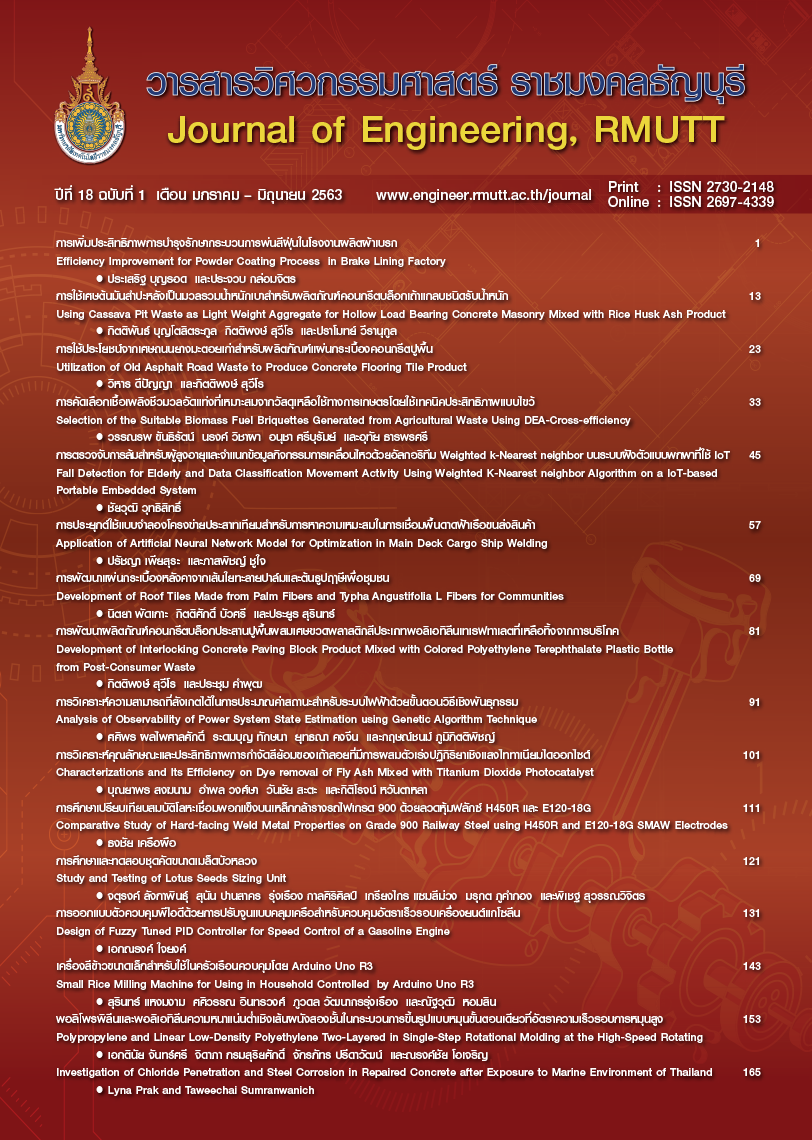การวิเคราะห์คุณลักษณะและประสิทธิภาพการกำจัดสีย้อมของเถ้าลอยที่มีการผสมตัวเร่งปฏิกิริยาเชิงแสงไททาเนียมไดออกไซด์
Main Article Content
บทคัดย่อ
งานวิจัยนี้มีวัตถุประสงค์ในการเจือตัวเร่งปฏิกิริยาเชิงแสง (TiO2-P25) สัดส่วน 0% 5% 10% และ 15% โดยน้ำหนักในเถ้าลอยจากโรงไฟฟ้าถ่านหินแม่เมาะ (x%TiO2/FA) ด้วยวิธีการผสมเชิงกล เพื่อนำไปผลิตเป็นจีโอพอลิเมอร์ ตัวอย่างผสมถูกวิเคราะห์คุณสมบัติทางกายภาพและเคมีของตัวเร่งปฏิกิริยาด้วยเทคนิค X-ray diffraction (XRD), N2 adsorption-desorption และ UV–vis diffuse reflectance spectroscopy (UV-DRS) และศึกษาประสิทธิภาพในการย่อยสลายสีย้อมรีแอคทีฟเรด 120 (RR120) ภายใต้รังสีอัลตราไวโอเลต ผลการทดลองพบว่าเมื่อปริมาณของตัวเร่ง TiO2-P25 เพิ่มขึ้น ความสูงของอนาเทสและรูไทน์เฟสสูงขึ้น และพื้นที่ผิวและขนาดของรูพรุนมีค่าเพิ่มขึ้น นอกจากนี้ค่าช่องว่างพลังงานของตัวอย่างผสมมีค่าเพิ่มขึ้นเมื่อมีปริมาณของตัวเร่งปฏิกิริยาเชิงแสงที่เพิ่มขึ้นเช่นกันจาก 2.46 ไปเป็น 3.05 eV สำหรับการศึกษาการย่อยสลายของสีย้อมได้ทำการศึกษาการย่อยสลายสีย้อม ที่ความเข้มข้นเริ่มต้น 20 ppm ค่า pH เท่ากับ 6 ผลพบว่าการย่อยสลายของสีย้อมที่เวลา 120 นาทีของตัวอย่างผสม 0% 5% 10% และ 15% มีค่าเท่ากับ 28.78% 51.23% 72.65% และ 82.74% ตามลำดับ แต่ตัวเร่ง TiO2-P25 สามารถย่อยสลายสีย้อมได้ 99.76% ผลการทดลองสามารถยืนยันได้ว่าเมื่อนำตัวอย่างผสมเถ้าลอยจากโรงไฟฟ้าถ่านหินแม่เมาะกับตัวเร่งปฏิกิริยาเชิงแสง (TiO2-P25) เป็นวัสดุตั้งต้นไปผลิตเป็นจีโอพอลิเมอร์จะมีความสามารถในการย่อยสลายสีย้อมได้
Article Details
บทความ ข้อมูล เนื้อหา รูปภาพ ฯลฯ ที่ได้รับการตีพิมพ์ในวารสารแนวหน้าวิจัยนวัตกรรมทางวิศวกรรม ถือเป็นลิขสิทธิ์ของวารสารฯ เท่านั้น ไม่อนุญาติให้บุคคลหรือหน่วยงานใดคัดลอกเนื้อหาทั้งหมดหรือส่วนหนึ่งส่วนใดไปเผยแพร่เพื่อกระทำการใด ๆ ที่ไม่ถูกต้องตามหลักจริยธรรม
เอกสารอ้างอิง
Department pollution control.[Internet]. 2019[cite 2019 sep 26];Availablefrom:http://www.pcd.go.th/info_serv/reg_std_water04.html
Teh CY, Budiman PM, Shak KPY, Wu TY. Recent advancement of coagulation-flocculation and Its application inwastewater treatment. Ind Eng Chem Res.2016;55(16):4363–89.
Modrogan C, Miron AR, Orbulet OD, Costache C, Apostol G. Ion exchange processes on weak acid resins for wastewater containing cooper ions treatment. Environ Eng Manag J.2018;14(2):449–54. [4]Lu L, Huang Z, Rau GH, Ren ZJ. Microbial electrolytic carbon capture for carbon negative and energy positive waste-water treatment. Environ Sci Technol. 2015;49(13):8193–201.
Abdel-Kader AM. Studying the efficiency of grey water treatment by using rotating biological contactors system. J King Saud Univ -Eng Sci. 2013;25(2):89–95.
Das R, Ali ME, Hamid SBA, Ramakrishna S, Chowdhury ZZ. Carbon nanotube membranes for water purification: A bright future in water desalination.Desalination. 2014;336(1):97–109.
Han Y, Xu Z, Gao C. Ultrathin graphene nanofiltration membrane for water purification. Adv Funct Mater. 2013;23(29):3693–700.
Gupta VK, Jain R, Mittal A, Saleh TA, Nayak A, Agarwal S, et al. Photocatalytic degradation of toxic dye amaranth on TiO2/UV in aqueous suspensions. Mater Sci Eng C. 2012;32(1):12–7.
Shavisi Y, Sharifnia S, Hosseini SN, Khadivi MA. Application of TiO2/perlitephotocatalysis for degradation ofammonia in wastewater. J Ind EngChem. 2014;20(1):278–83.
Zhao D, Sheng G, Chen C, Wang X.Enhanced photocatalytic degradation of methylene blue under visibleirradiation on graphene@TiO2dyedestructure. Appl Catal B Environ.2012;111–112:303–8.
Zhang Z, Xu Y, Ma X, Li F, Liu D, Chen Z, etal. Microwave degradation of methyl orange dye in aqueous solution in the presence of nano-TiO2supportedactivated carbon (supported-TiO2/AC/MW).J Hazard Mater. 2012;209–210:271–7.
Duta A, Visa M. Simultaneous removal of two industrialdyes by adsorption and photocatalysis on a fly-ash-TiO2composite. J Photochem Photobiol A Chem. 2015;306:21–30.
Al-Harbi LM, Kosa SA, Abd El Maksod IH, Hegazy EZ. The photocatalytic activity of TiO2-zeolite composite for degradationof dye using synthetic UV and Jeddah sunlight. J Nanomater. 2015;1-7. [14]Fatimah I, Said A, Hasanah UA. Preparation of TiO2-SiO2using rice husk ash as silica source and the kinetics study as photocatalyst in methyl violetdecolorization. Bull Chem React Eng Catal. 2015;10(1):43–9.
Electricity generating authority of Thailand[Internet].2019[cite 2019 sep 26];Availablefrom:http://maemoh.egat.com/index.php?option=com_content&view=article&id=89:sarat1&catid=89&Itemid=435.
Ökte AN, Karamanis D, Tuncel D. Dualfunctionality of TiO2-flyash nanocomposites:Water vapor adsorption and photocatalysis.Catal Today. 2014;230:205–13.
Visa M, Isac L, Duta A. New fly ash TiO2composite for the sustainable treatmentof wastewater with complex pollutantsload. Appl Surf Sci. 2015;339(1):62–8.
Shi Z, Yao S, Sui C. Application of fly ash supported titanium dioxide for phenol photodegradation in aqueous solution. Catal Sci Technol. 2011;1(5):817–22.
Saud PS, Pant B, Park M, Chae SH, Park SJ, Ei-Newehy M, et al. Preparation and photocatalytic activity of fly ashincorporated TiO2nanofibers for effective removal of organic pollutants.Ceram Int. 2015;41(1):1771–7.
Ganji N, Allahverdi A, NaeimpoorF, Mahinroosta M. Photocatalytic effect of nano-TiO2loaded cement on dye decolorization and Escherichia coli inactivation under UV irradiation. Res Chem Intermed. 2016;42(6):5395–412.
Strini A, Roviello G, Ricciotti L, Ferone C, Messina F, Schiavi L, et al. TiO2-based photocatalytic geopolymers for nitric oxide degradation. Materials (Basel). 2016;9(7):1–13.
Versus T, Calcination TA. Geopolymer-TiO2Nanocomposites for Photocsatalysis: Synthesis by One-Step Adding TreatmentVersus Two-Step Acidification Calcination.Mineral 2019;9:658-64.
Banerjee S, Sharma GC, Chattopadhyaya MC, Sharma YC. Kinetic and equilibrium modeling for the adsorptive removal of methylene blue from aqueous solutions on of activated fly ash(AFSH). J Environ Chem Eng. 2014;2(3):1870–80.
M Ramazani, M Farahmandjou TF. Effect of Nitric acid on Particle Morphology of the Nano-TiO2. Int J NanosciNanotechnol. 2015;11(2):115–22.
Zuo R, Du G, Zhang W, Liu L, Liu Y, Mei L, et al. Photocatalytic degradation of methylene blue using TiO2impregnateddiatomite. Adv Mater Sci Eng. 2014;1-7.
Suwannaruang T, Kidkhunthod P, Chanlek N, Soontaranon S, Wantala K. High anatase purity of nitrogen-doped TiO2nanorice particles for thephotocatalytic treatment activity ofpharmaceutical wastewater. Appl Surf Sci. 2019;478(October 2018):1–14.
Pant B, Ojha GP, Kim HY, Park M, Park SJ. Fly-ash-incorporated electrospun zinc oxide nanofibers: Potential material for environmental remediation. EnvironPollut. 2019;245:163–72.
Djellabi R, Ghorab MF, Cerrato G, Morandi S, Gatto S, Oldani V, et al. Photoactive TiO2-montmorillonite composite fordegradation of organic dyes in water. J Photochem Photobiol AChem. 2015;295:57–63.
BelHadjltaief H, Ben Zina M, Galvez ME, Da Costa P. Photocatalytic degradation of methyl green dye in aqueous solution over natural clay-supported ZnO-TiO2catalysts. J Photochem Photobiol A Chem. 2016;315:25–33.
Li ZD, Wang HL, Wei XN, Liu XY, Yang YF, Jiang WF. Preparation and photocatalyticperformance of magnetic Fe3O4@TiO2core-shell microspheres supported by silica aerogels from industrial fly ash. J Alloys Compd. 2016;659:240–7.
Wang HL, Qi HP, Wei XN, Liu XY, Jiang WF. Photocatalytic activity of TiO2supported SiO2-Al2O3aerogels preparedfrom industrial fly ash. Cuihua Xuebao/Chinese J Catal. 2016;37(11):2025–33.


